One of the key factors that increases your risk of tearing a calf muscle, is a shortened Gastrocnemius and Soleus muscle. Runners are more likely to tear one of their calf muscles. This is because calf muscles contract at high intensity to allow the runner to push off with enough force between each stride. People who practice activities involving jumping, for example long jump athletes, run an even higher risk of tearing their calf muscles. Muscles often tear because of the strain on the area where muscles join with tendon and bone. Torn calf muscles, among other muscle injuries, can be treated by a Physiotherapist.
What is the calf made up of?
Your calf consists of 2 large muscles – Gastrocnemius and Soleus muscles. Gastrocnemius is the one on top (giving you that curved look) with Soleus just beneath it. The Gastrocnemius muscle has two heads (medial – on the inside and lateral – on the outside) and it crosses both the ankle and knee joints which makes it vulnerable to injury. The two muscles run closely together, joining to form the Achilles tendon, which anchors the two muscles to the back of the heel bone. Calf muscles can be injured or even tear due to overstretching or overuse.
Both the calf muscles are attached to tendons on each side called the Musculo-tendinous junction. One at the top (called the proximal) and one at the bottom (called distal). The most common place where calf muscles tear are at this joining points of muscle and tendon.
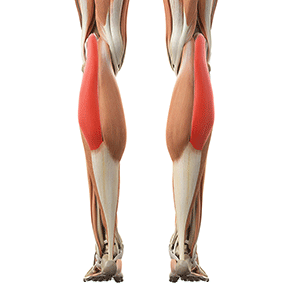
What do the calf muscles do?
The superficial Gastrocnemius muscle, crosses both the knee and ankle joints. When a muscle crosses two joints it is already more vulnerable to injury, because of active insufficiency. This means that when a muscle is lengthened over two joints, it cannot exert maximum force. Contracting the Gastrocnemius muscle causes the ankle to plantarflex (the position that the ankle goes into when you point your toes).
It works hardest during high impact forward propulsion, like in a sprint, running up a hill or jumping. The deeper Soleus muscle only crosses the ankle joint, also helping to plantar flexion at the ankle. Soleus muscles works hardest during lower impact endurance activities, think marathons. That repetitive push off movement.
Fibrous tissue formation
Scar tissue needs to be formed after an injury or tear to heal your calf muscle. This scar tissue is like a scab forming over a wound on your skin. The scar tissue needs to form in the same direction as the muscle fibers, be of the same length and able to withstand the forces that will be loaded onto the muscle. Optimal, functional scarring will allow you to return to your sport, without re-injuring it.
If you keep running through the pain, you’re ripping the wound tissue wide open again. Expect your body to repair it again while you rest, leading to a cycle of repair and breakdown of your calf muscle fibers.
It will eventually lead to damage control, poorly placed, thick scar tissue to form that looks like a dense web of scattered fibers called a fibrous scar. This web of scar tissue can attach itself to arteries, veins and nerves in the area, apart from the fact that it will restrict the normal sliding of the muscle fibers, you may get nerve pain as well. You won’t fix the dent in your car without having it smoothed, polished and coloured, so why don’t you go through the same trouble for your calf?
How does a Calf muscle tear happen?
When a muscle needs to contract at a very high rate and force, this overload of ‘pulling’ on the muscle causes small microscopic tears in the muscle fibers. A combination of overload while your muscle is stretched, puts your calf muscle fibers under even more strain. Our bodies react to these micro tears by activating the nervous system to tell the muscle it has been injured. Your nervous system will react by contracting that muscle and increasing the muscle tension (to protect itself). This results a temporary shortening of the muscle to allow healing to take place.
After you’ve torn your calf muscles, when you push off your heels like jumping, you will feel a sharp stinging feeling. This is because the more you contract and stretch it, the more you will damage the scar which is trying to heal the muscle fibers. Its like ripping the wound wide open again.
What causes the calf muscle to tear?
Overload – Increasing the weight on a calf raise machine too fast. You can just imagine if you jump from 40kg to 60kg in one week. The muscle won’t be able to keep up.
Inadequate warm-up – A fast sudden contraction like a jump or start sprinting while your calf muscle is not prepared for it, can put you at risk of tearing the muscles.
Overstretch – Running hills or on a incline will force the muscles to contract from its stretched position. A sudden contraction from a stretched position, where muscles are very weak, puts the calf muscles under enough strain to shear the fibers.
Weakness – Muscle fatigue can play a role in runners who are not able to maintain the muscle contraction. Calf muscle endurance and conditioning to be able to handle repetitive contractions of your muscle. When fatigue kicks in, the muscle gives in.
Poor technique – During training (Wrong movement pattern), overpronation of the ankle can cause forces to focus over the inside of the calf, that can load the medial Gastroc head significantly more. More load, leads to overload…
Overuse – Increasing your running distance too fast or sudden high repetition of calf raises and jumps. A sudden change in your interval training, or hill sprints are a dangerous area to venture in. Increasing your pace, distance and frequency (Change from 2 to 4 times per week) all at the same time.
Excessive stretching – of the muscle against a force, for example during calf rises, when the load is applied on both sides of the tendon, while it needs to contract and lengthen at the same time. Excessive stretching of a “stiff” calf – means there’s already a problem. (Forces concentrating in a certain area of your calf muscle)
Wrong shoes – Poor support for your foot will cause muscle forces to concentrate along the inside of your calf, which loads those muscle fibers more that the outer part. These abnormal forces on the inside of your calf will cause the fibers to fatigue faster and tear first.
Calf muscle tears have jokingly been baptized “tennis leg” among sport care practitioners, because of the high incidence of patients sustaining a tear during a tennis match, when they propel to get to the ball from across the court.
Its like being hit by the ball on your calf. This can cause some confusion as to where the ball is, or even lead to some quarreling among team mates. Until they realize they’ve torn their calf muscles.
Where calf muscles tear
Longitudinal tears inside the muscle belly are the most frequent that we see. This is a tear along the direction of the fibers meaning a split of the muscle sideways tearing from top to bottom. Like opening a zip.
Mostly between the two heads of the Gastrocnemius muscle (the two heads split apart) or in the medial head of the Gastrocnemius due to it taking much more load compared to the outside (lateral) head.
Transverse tears are tears that rip across the fibers from the inside to the outside. This type of tear is very dangerous because the chances of tearing more fibers are very high or even a complete rupture. We see this usually between the attachment of the Gastrocnemius and Soleus muscle onto the Achilles tendon.
Soleus Muscle tears: The Soleus muscle tends to rip off its deep attachment on the back of the tibia. This presents more like a shin pain (Traction Periostitis) and is less common to tear from a single forceful contraction. With a traumatic tear, the Soleus muscle will tear when the knee is bent. It needs to absorbs a lot more force when the covering Gastrocnemius muscle is less active. Then it tends to tear at the distal musculotendinous junction, where the Soleus attaches to the Achilles tendon.
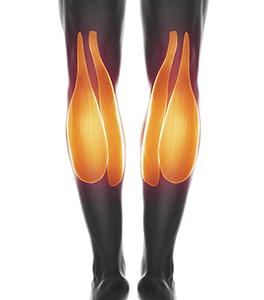
Diagnosis
Our physiotherapists are experts at detecting a muscle tear because we spend 11 hours a day working on soft tissue. As they say, “we just have the feeling for it”. We test the range of movement from your knee and ankle. Testing involves you pointing and flexing your foot in various positions, with and without resistance. This gives us an indication of the muscle length. We test the Gastrocnemius and Soleus muscles’ strength individually by evaluating your ability to rise onto your toes with the knee at various angles, with and without bearing weight. Ways to confirm a calf muscle tear diagnosis is to see it and then measure the width, depth and length of the tear using Sonar or Ultrasound (Diagnostic Sonar).
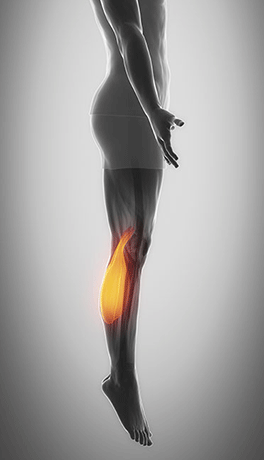
Sonar
Diagnostic Ultrasound (Sonar) is the investigation method of choice because it allows the soft tissue (muscles, ligaments and bleeding) to become visible. Therefore, Sonar shows the depth, length and direction of the muscle tear. This enables us, as physiotherapists, to treat you effectively.
X-Rays
In some cases we may refer you for an X-ray to exclude any knee or ankle pathology. This however, is rare. X-rays show only bones and therefore does not give us an indication of what in happening in the muscles. X-rays will only be necessary if we suspect a stress fracture of the Tibia or an avulsion fracture of the Achilles tendon.
MRI
A MRI is only needed if the interosseous membrane is injured. The interosseous membrane of the leg (middle tibiofibular ligament) extends between the Tibia and Fibula. This membrane helps stabilize the Tib-Fib relationship and distance between the two bones of the lower leg. Furthermore the membrane separates the muscles on the front from those on the back of the leg. Injury to the calf muscles involving this membrane is a serious problem, causing the tibia and fibula to split apart ‘gaping’ the bones from each other.
Testing to confirm the seriousness of the injury
We use a scale from 1 to 3 to determine how serious a tear in the calf muscle is. What follows is a short breakdown these different scales. Click here for more detailed information on general muscle spams, cramps and tears.
1st Degree (Mild)
When less than 20% of the muscle fibers are torn the injury can be referred to as a pulled muscle.
When the calf muscle is stretched by standing on the edge of a step and allowing the heel to hang over the edge of the step, the Gastrocnemius muscle will stretch when the knee is kept straight. The Soleus muscle will stretch when the knee is bent.
You will be able to put your weight on the leg, but you will experience some pain when walking. No swelling or bruising will be visible. Tenderness over the tear can be felt and a slight hardness around the tear due to the muscle guarding. Calf muscle cramps and spasms are common.
A small strain on a muscle should heal within a week without medical treatment. If the pain hasn’t subsided in 3 days, give us a call so we can have a look at it.
Recovery Time is 2 to 4 weeks if you follow the treatment advice and instructions that we give you.
Symptoms of a 1st degree Calf muscle tear
- Able to continue playing (sport), jogging, but with pain.
- Pain only at the end of range (when you pull your toes toward your head)
- No loss of muscle strength (Able to do a calf raise with pain)
- Dull pain when standing on the edge of a step, drop your heel off the step
- Little swelling
- No bruising visible (blue)
- Unable to pinpoint it to one specific spot in the calf
2nd Degree (Moderate)
20% – 80% of muscle fibers are torn.
You will be unable to put weight on the injured leg or feel more than 5/10 pain in the calf when walking (for those with higher pain threshold). Sharp stinging pain when walking up a hill or incline. This will cause a pull over the tear and produce more pain.
When stretched by just sitting and pulling your toes up will bring on the pain. Pointing your toes will also cause pain. Usually there will be bruising visible, but only after 24 hours (This is usually first noted along the ankle and on the inside of the heel or underneath the arch of the foot).
There will be sharp pain when applying pressure to the tear and in some cases a clear indent or ‘gap’ can be felt. After the swelling have disappeared (3 days) you should be able to feel a bump or dip where the most painful spot is.
Contact us immediately because you need medical treatment. The faster we have a look at it before the swelling and bleeding gets too much, we can determine where the tear is and distinguish which of the calf muscles are torn: Gastrocnenius(top) or Soleus(deeper) muscle .
The time it will take to recover enough to be able to run, is 2 to 4 weeks. A full recovery will take 4 to 8 weeks.
Symptoms of a 2nd degree Calf muscle tear
- Hear a pop or snap when it happens.
- Unable to continue play (sport), have to stop moving (running, jumping)
- Pain through the range as you point and pull your toes upwards
- Loss of muscle strength (Unable to perform a calf raise)
- Sharp pain when stretched (Toes pulled to your head)
- Little to severe swelling (Mainly around the ankle)
- With or without bleeding under skin (bruising visible – blue)
- Able to pinpoint it to one specific spot
3rd Degree (Severe)
Severe muscle tear, resulting in the calf muscle being torn to pieces. This is the most severe tear with a complete rupture of the muscle fibers, and will require surgical reattachment of the muscle.
The main sign will be minimal pain and severe loss of movement. When you try to point your toe, the calf muscle will contract, but there will be very little movement in your foot. If the muscle tears right through (100% of fibers affected), it will leave the muscle in two separate pieces.
Contact us immediately because you need medical treatment. The faster we have a look at it before the swelling and bleeding gets too much, we can determine where the tear was and how many muscles were torn. Depending on the muscles affected, surgery will be required to attach the separate muscle pieces.
Recovery Period is usually 3 to 4 Months depending on the site of the tear.
Symptoms
- Hearing a loud pop, snap when it happens.
- Unable to continue playing, have to stop moving
- Minimal or No pain
- Able to contract the muscle, but no movement occurs (The ankle just flops forward and backwards)
- Severe pain when stretched
- Always swelling
- Always considerable amount of bleeding under skin
- Able to pinpoint and see the two lose ends of the torn calf muscle
- Gap visible
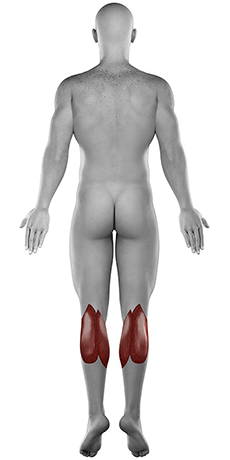
Tests to establish the seriousness of the injury
- Stand with your feet slightly apart, weight equally distributed, holding onto something solid for balance if you need it, keep the knees straight.
- Rise up onto your toes, lifting your heels as high as possible. Keep your body upright (don’t bend forwards).
- Ensure that your knee stays straight as you rise.
If you feel pain with this test it may indicate that you have a Gastrocnemius muscle strain/tear.
- Stand with your feet slightly apart, weight equally distributed, holding onto something solid for balance if needed
- Bend your knees to about 60 degrees.
- Rise up onto your toes lifting your heels as high as possible. Keep your body upright (don’t bend forwards).
- Ensure that your knees stay bent as you rise.
If you feel pain during this test, it may indicate that you have a Soleus muscle strain/tear.
- Stand with the balls of your feet slightly apart on the edge of a stair, weight equally distributed, holding onto something solid for balance if you need it, keep the knees straight.
- Drop the heels downs, so that your toes are higher than your heels, when looking from the side. Keep your body upright (don’t bend forwards).
- Ensure that your knee stays straight as you lower.
If you feel pain with this test it may indicate that you have a Gastrocnemius muscle strain/tear.
- Stand with the balls of your feet slightly apart on a stair, weight equally distributed, holding onto something solid for balance if you need it, bend the knees to about 60 degrees.
- Drop the heels downs, so that your toes are higher than your heels, when looking from the side. Keep your body upright (don’t bend forwards).
- Ensure that your knees stays bent.
If you feel pain with this test it may indicate that you have a Soleus muscle strain/tear.
- Lay down on your back, with your knees bent at 60 degrees.
- Lift your buttocks up (like doing a bridge)
- Raise your heels off the floor to do a full rise., to load the Soleus even more alternate to lift the legs off the floor while holding the position. Rise and lower your calf to the floor 10 times on each leg.
If you feel pain during this test, it may indicate that you have a Soleus muscle strain/tear.
Why my calf pain doesn’t go away
If you are asking yourself ‘why is it taking so long for the pain to go away’ then you might want to consider the following. When the muscle tears the body attempts to repair the injured fibers by sending cells to reattach the torn ends of the fibers.
It reacts similar to repairing an open wound. Like having a cut at the bottom of your foot. If you keep on walking on it, you will shear away the cells that are healing and closing the wound. The more you walk or run through the pain, the longer it will take to heal.If the pain returns every time you start running again, you have missed the most vital aspect of the cause of the muscle tear. The muscle length must return to normal before you return to participating.
Then you decide its a good idea to ‘rest your calf’, so you take a few days off. Eventually the pain in the calf goes away (usually 3 days), but when you try running again, the pain just returns. If the muscle length is not restored, you will rip the wound wide open and start from the beginning again. This is the most common reason why patients consult us, because they get stuck in this cycle of repair and breakdown. Some patients just give up and ‘accept it’, whereas others decide to ask your expertise.
If you are taking anti-inflammatory medication for the calf muscle tear, STOP taking them. Inflammation is the body’s natural way of healing the injured muscle fibers. The medication is preventing this repair process from taking place, not to mention, masking the effect of the trauma on the tissue when you return to running while still taking anti-inflammatory medications.
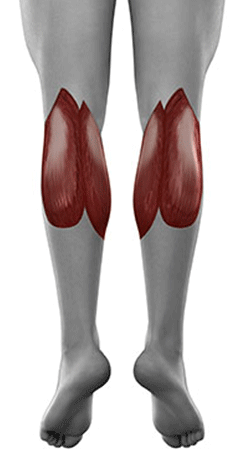
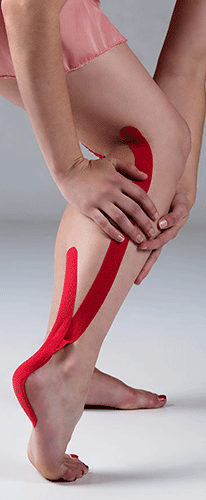
Loading the Calf muscle and tendon to stimulate healing
- While rest may be helpful in the very short term, continued rest may lead to deconditioning of the tissues – joint stiffness, muscle weakness, tightness and less proprioception (control and balance).
- Optimal loading will stimulate the healing process as bone, tendon, ligament and muscle all require some loading to stimulate healing
- The right amount of activity can help manage swelling. For example in the ankle, contraction of the calf muscles helps to move swelling by stimulating a venous return of blood flow back to the heart (against gravity). The muscle functions as a pump, when the muscle contracts pressure is applied to the veins, which aids in circulation. This will prevent the swelling from building up in your calf by improving blood supply around the injured tissue. In short, complete rest will prevent this.
I’m not suggesting you ditch your crutches and run off down the street! When it comes to managing an acute calf strain we recommend you seek medical advice, especially if there is noticeable swelling or any restriction of your ankle range of movement.
We have to adopt a policy of weight-bearing as tolerated. Meaning do as much as you feel comfortable to do and don’t push through pain. This usually fits within the idea of optimal loading, but if in doubt, call us. This also includes exercises, we encourage people to gently move the joints around the knee and ankle, again listening to the body and not pushing through pain. It’s better to do these small movements than to end up with a stiff knee or ankle joint. Do not overdo it, or you may just cause more pain. Offload taping is very useful to support an area when you load it.
Physiotherapist treatment
A muscle tear can re-attach successfully if you guide and protect it throughout its healing phases.
Our Physiotherapists follow the 6 phase rehabilitation process where we guide you through each step.
Treatment and Rehabilitation
- Physiotherapy treatment focuses on pain management and accelerating the healing process by using Ultrasound and Laser
- Strapping and Taping to support and protect from further injury.
- Acupuncture or Dry Needling of the Gastrocnemius and Soleus muscles.
- Electrotherapy
- Massage, Soft tissue mobilization and muscle Stretches to lengthen the shortened muscles.
- Myofascial release of the calf muscles to guide the scar tissue formation.
- Dynamic, static and ballistic stretches together with eccentric loading exercises to condition the muscle fibers.
- Compression braces like compression socks or neoprene sleeve can promote blood flow through the site of injury and prevent the blood pooling in the lower leg.
- Crutches to immobilize the calf for the first few days or weeks.
- We will gradually progress your rehabilitation exercises to regain full function of the Gastrocnemius and Soleus muscles.
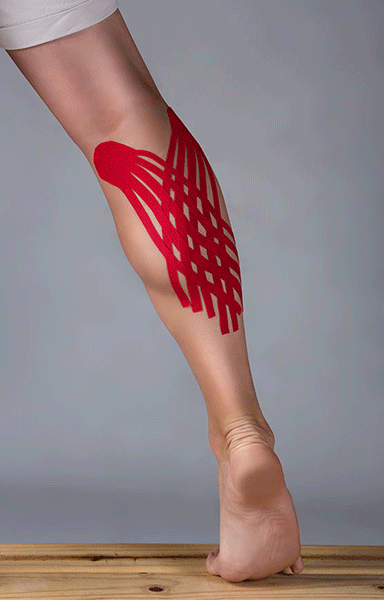
PRICE protocol
1st Phase: Protection & initial Healing
P
Protect.
We have found that patients tend to continue walking on the injured leg with a limp. The muscle still contracts every time that your weight is put onto the leg. It’s better to get crutches and keep the load off your calf. The main concern is to prevent your calf muscles from tearing even further.
R
Rest.
No weight on the injured leg. Use crutches to take the load off the muscle.
As soon as there’s no pain, don’t test it. Give it time to fuse completely.
I
Ice.
Ice cubes warped in a towel, tied around the calf reduces pain & inflammation and speeds up the healing process. For at least the first 3 days or until the swelling goes down, apply an ice pack for 20 minutes every two hours. Always keep a towel between the ice and your skin (to prevent a clod burn), and press the ice pack firmly against all the curves of your calf.
C
Compress.
Use strapping (Leukotake S) or elastic compression bandage to keep the muscle supported and prevent blood pooling in your calf. This can be done either with taping or tube grip bandage and helps to control swelling.
E
Elevate.
Lying on your back with your foot on a chair (your calf must be higher than your heart to allow gravity to assist in draining the pooled blood in your leg.) Raise your calf for 15 minute intervals during the day.
2nd Phase: Regain Full Range of Movement
The most important component of rehabilitation is to regain full range of movement of the muscle fibers. The scar tissue that form inside the site of the tear must be lengthened and orientated to allow the muscle to contract without any restrictions. We use massage, stretches and neurodynamic mobilizations to achieve full range of movement. This will also prevent future reoccurrence.
3rd Phase: Eccentric Muscle Strength
Its common to feel some pain when we start contracting the muscle – this is due to breaking down abnormal fibrous tissue adhesion, that restricts the Gastroc from sliding over the Soleus muscle. A muscle contraction works in two directions: One where the calf muscle is contracted and it shortens like a heel rise (concentric), and controlling the descent going down from a heel rise (eccentric). This loads your calf muscle fibers while being lengthening. These type of exercises is vital at conditioning the muscle fibers to absorb a force.
4th Phase: Concentric Muscle Strength
Shortening of the muscle during a contraction involves strength and power exercises that will be progressed gradually as healing takes place. This will be tested frequently to determine if you can progress from non-weight bearing to full weight bearing (walking without crutches). Our physiotherapist will guide and monitor your calf muscles’ reaction to normal forces like walking, climbing stairs and driving.
5th Phase: High Speed, Power, Proprioception
The calf muscles must be tested under high load and speed to ensure that the muscle will be able to keep up with the demand of your body. During this phase the physiotherapist will guide you to return to normal activities, this includes challenging your muscle past its ‘normal’ boundaries to determine how it reacts to different forces. Ultimately we prepare you to return to participating in your sport.
Whatever must be done – we’ll get you there. Jumps, Landing, Sprints, and much more.
6th Phase: Sport Specific Training
Depending on your sport, our physiotherapist will tailor specific exercises that will help strengthen the muscles pertaining to your sport. A successful outcome is when you have gained knowledge throughout the rehabilitation program and can participate at full power and speed, not to mention the benefits of minimizing your chance of future injury.
Signs of Calf pain that can be life threatening
Deep Venous Thrombosis (DVT)
Symptoms of DVT overlap with a calf injury, but the main distinguishing factors are:
- Warmth over the skin of the calf
- Redness or discoloration of the skin in the calf
- Excessive pain from your injury
A DVT can develop after an injury or not being able to move your leg for a few weeks after a prolonged period of immobilisation, like bedrest or a long haul flight. It can happen to anybody, regardless of your age.
General Practitioners tend to send patients for an Ultrasound (Diagnostic Sonar) investigation of a suspected DVT, where they can see the veins in the calf and determine if there is any obstruction in blood flow back to your heart.
If the thrombosis can be seen, the test is positive, and they will admit you to the hospital for observation and start you on a variety of anticoagulant medications. A DVT is a serious condition and can lead to pulmonary embolism (where the blood clot moves to the lungs, obstructing your ability to breath) which is potentially life threatening.
If the test is negative, your Sonographer will search for signs of a muscle tear.
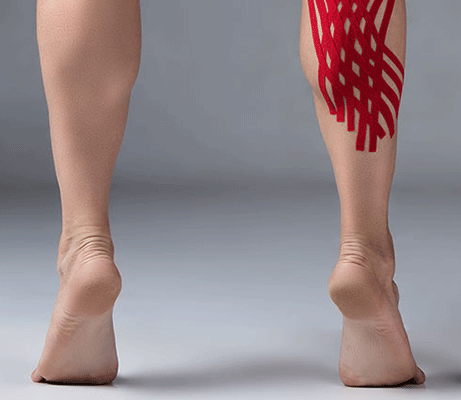
Surgery of a calf muscle tear
Surgery would only be considered for a Achilles tendon rupture. Normal sutures cannot hold muscle fibers together. Therefor a calf muscle tear would be treated conservatively with physiotherapy.
What else could calf muscle pain be
Achilles tendinosis or tendinitis
Inflammation of the Achilles tendon itself will cause localised pain over the tendon at the back of the leg. It can be at the base of the Gastrocnemius and Soleus muscles, where the tendon starts, or where the tendon attaches to the heel. Tendinitis will normally be painful at rest, go away during activity and return after cool down.
Flexor Digitorum Longus muscle tear
Injury to this muscle is common in ballet dancers, due to the repetitive plantar flexion needed at the ankle. This will cause pain more localised to the ankle and foot, especially bad when taking weight on the affected side, cramping of the foot or even clawing a deformity of the foot.
Shin Splints:
This is when the Deeper Soleus muscle tears away from your shin bone, the concern is more around the bone taking all the impact as opposed to the muscle tear itself.
Posterior Tibial nerve entrapment
The posterior tibial nerve can become entrapped along the path it follows from below the knee, through the calf and entering the foot. Symptoms of entrapment may include cramping, pins and needles, burning sensation along the calf or ankle.
Gastrocnemius or Soleus muscle cramp
Cramps are sudden, painful, involuntary contractions of the muscles due to overexertion, dehydration, dietary insufficiency or decreased flexibility.
Deep Venous Thrombosis
DVT, as discussed above, is a dangerous condition and should be treated immediately.
Posterior Compartment Syndrome
The muscles in the lower leg are surrounded by sheaths. When the pressure rises too much because of exertion or swelling pain may be experienced. This will be painful during a exercise and go away completely during rest, only to return with exercise again.
Calf muscle tear – Also Known as
Calf muscle strains, pulled calf muscle, torn calf muscle.

